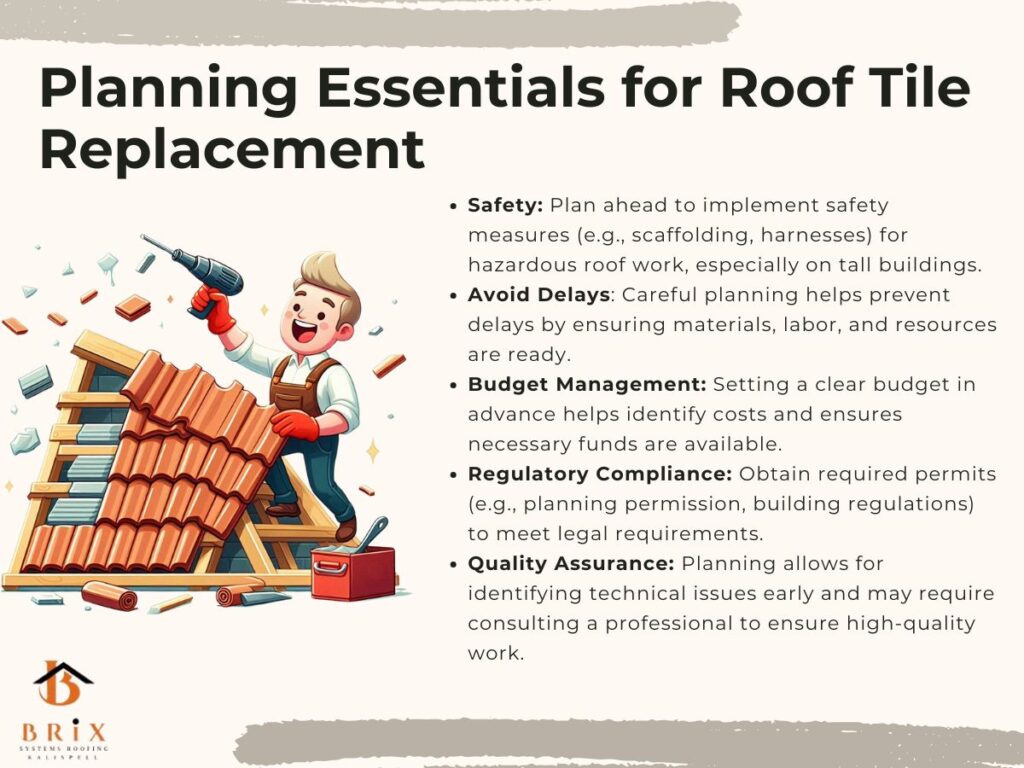
Roofs are crucial to the integrity of any structure. In addition to keeping the structure safe from the elements, it also aids in keeping the building's framework in good shape. As such, it is important to ensure that the roof is in good condition and that any necessary repairs or replacements are carried out promptly.
One common repair that may be needed is replacing roof tiles. But do you need planning to do this? Brix Systems has been taking care of the neighborhood's roofing requirements for almost ten years, including tile installation. Find out whether you need to planning to change your roof tiles and why in this article.

If you are considering changing the roof tiles on your building, it is important to plan carefully beforehand. While replacing roof tiles can be a necessary part of maintaining the structure and integrity of your building, it is also a complex and potentially costly process.
By planning ahead, you can ensure that the work is carried out safely, efficiently, and within budget. There are several reasons why planning is important when it comes to replacing roof tiles. These include:
It is important to make sure that you are aware of and comply with any necessary rules and regulations, such as planning permission or listed building consent. By planning carefully, you can avoid delays and ensure that the work is carried out to a high standard.
You should consider several things when planning to change the roof tiles on your building. These include:
The short answer to this question is: it depends. Whether or not you need a building permit to replace roof tiles is determined by a variety of factors, including the building's type, its location, and the scope of the work to be done.
In general, you will not need planning permission to change your roof tiles if the work is considered to be "permitted development." Permitted development refers to certain types of work that can be carried out without the need for planning permission, provided that they meet certain criteria.
There are also some specific circumstances in which you may be able to change your roof tiles without planning permission, even if the work would normally require it. For example, you may be able to carry out the work as part of a larger repair or maintenance project, provided that the work does not involve any significant changes to the roof.
Planning approval will be required if the proposed work does not fall under the category of authorized development or if it is not clear whether it does. You should have all the required data and paperwork ready before beginning this process, as it can be intricate and time-consuming.
When it comes to making changes to the exterior of your home, obtaining planning permission can be an important step. This is especially true when it comes to changes to the roof, as the roof is a visible and significant part of your home's overall appearance.
Generally, you will need planning permission to change the tiles on your roof if the changes will result in a significant alteration to the appearance of your home. This can include changing the color or material of the tiles, as well as making changes to the pitch or slope of the roof.
However, there are some situations where you may be able to make changes to your roof tiles without planning permission. If you're debating whether or not to replace your roof tiles, here are some factors to think about:
Check local building regulations: The first step in determining whether or not you need planning to change your roof tiles is to check local building regulations. These regulations vary from one location to another, and they can often be found on the website of your local council or planning department. Building regulations typically outline the types of changes permitted without planning permission and the circumstances in which planning permission is required.
Consider the appearance of your home: As mentioned, you will generally need planning permission to change the tiles on your roof if the changes will result in a significant alteration to the appearance of your home. This can include changing the color or material of the tiles, as well as making changes to the pitch or slope of the roof. If you are planning to make changes that are consistent with the existing appearance of your home, you may be able to do so without planning permission.
Consider the size and location of your home: The size and location of your home can also be factors in deciding whether or not you need planning to change your roof tiles. For example, if you live in a large or visually prominent home, you may be more likely to need planning permission to make changes to the roof. Similarly, if your home is located in a conservation area or other protected area, you may be subject to stricter planning regulations.
Consider the type of change being made: Some types of changes to your roof tiles may be more likely to require planning permission than others. For example, replacing your tiles with a completely different type of material may be more likely to require planning permission than simply replacing your tiles with a similar type of tile in the same color.
Seek professional advice: If you are unsure whether or not you need planning to change your roof tiles, it can be helpful to seek the advice of a professional. This can include a building surveyor, an architect, or a planning consultant. They will be able to help you understand the specific regulations that apply to your property and advise you on the best course of action.
Look into permitted development rights: In some cases, you may be able to make changes to your roof tiles without planning permission if you have what are known as "permitted development rights." These rights allow you to make certain types of changes to your property without seeking planning permission, as long as the changes are within certain guidelines. Permitted development rights can vary depending on the location of your property and other factors, so it is important to check with your local council or planning department to determine what is permitted in your case.
Check for any covenants or agreements: In addition to building regulations and permitted development rights, you may also need to consider any covenants or agreements that apply to your property. These can include agreements with a homeowners' association or other parties that place restrictions on the types of changes that can be made to your property. If you are planning to make changes to your roof tiles and you are subject to covenants or agreements, it is important to review these carefully to ensure that you are in compliance.
Consider the condition of your existing tiles: When deciding whether or not to change your roof tiles, it is important to consider the condition of your existing tiles. If your tiles are in good condition and need not be replaced, you may not need to make any changes. If, however, your tiles are damaged and need replacement, you may have to make structural adjustments to your roof.
Consider the cost and benefits of making changes: Another factor to consider when deciding whether or not to change your roof tiles is the cost and benefits of doing so. Depending on the type of change you are considering, there may be significant costs involved in making changes to your roof tiles. This can include the cost of materials, labor, and any necessary permits or fees. It is important to carefully weigh the costs against the potential benefits of making the change, such as improved appearance or increased energy efficiency, in order to make an informed decision.
Consider the long-term effects of the change: When making changes to your roof tiles, it is also important to consider the long-term effects of the change. This can include the expected lifespan of the new tiles and any potential maintenance or repair needs that may arise in the future. The decision to implement the modification or not can be made with more certainty if you think about the long-term consequences.
If you are planning to change the roof tiles on a listed building, the rules are slightly different. A listed building is one that has been recognized for its significant architectural or historical value and is therefore afforded legal protection.
If you own a listed building, you will need to apply for a listed building consent before carrying out any work that could affect its character or appearance. This includes replacing the roof tiles.
Listed building consent is separate from planning permission, and the local planning authority administers it. In order to obtain listed building consent, you will need to demonstrate that the work you are proposing is necessary and that it will not have a negative impact on the character or appearance of the building.
You may also need to provide additional information, such as details of the materials you plan to use and any other relevant documentation. In addition to obtaining planning permission or listed building consent, it is also important to consider any other factors that may affect the safety or integrity of your roof.
For example, you should ensure that the new tiles are compatible with the existing roof structure and that they are installed correctly. It may be necessary to seek the advice of a professional roofing contractor or engineer to ensure that the work is carried out to a high standard.